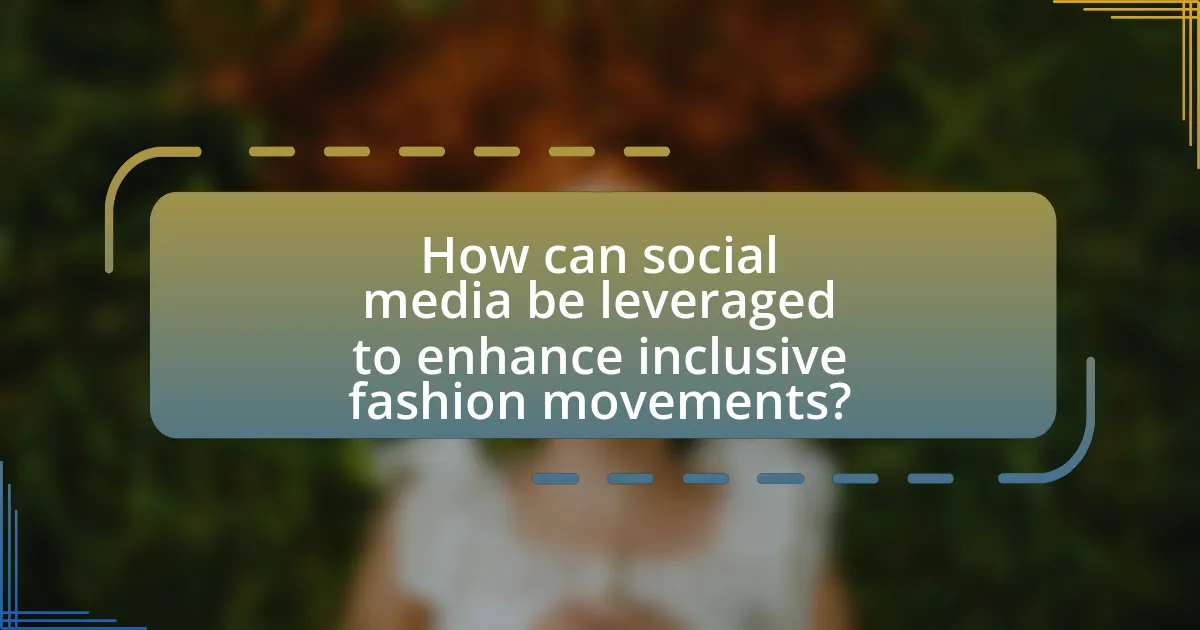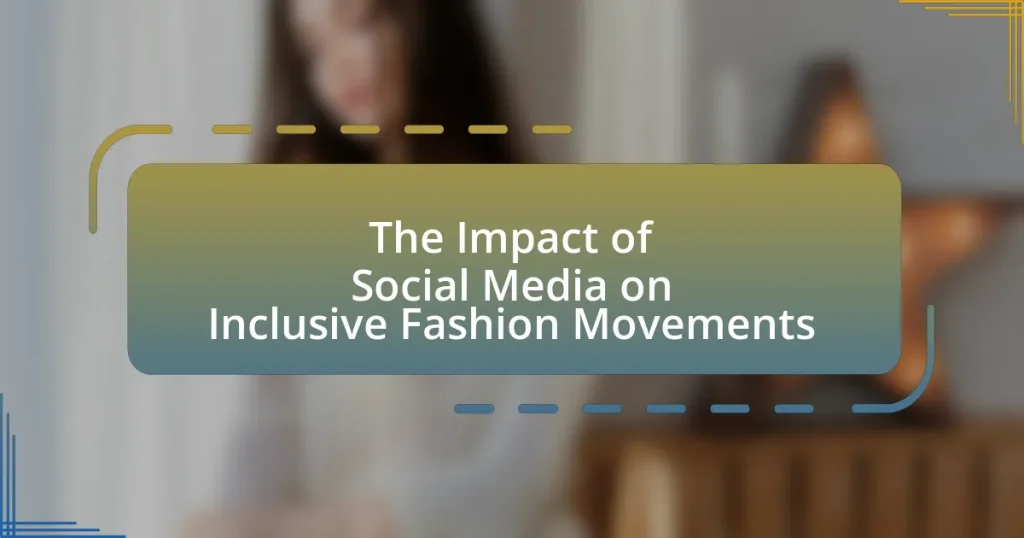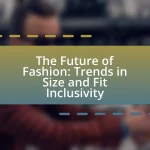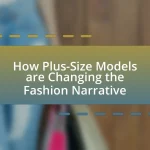The article examines the impact of social media on inclusive fashion movements, highlighting how platforms like Instagram and Twitter facilitate diverse representation and advocacy for body positivity, accessibility, and diversity in fashion. It discusses the role of influencers in promoting inclusivity, the importance of community building through social media, and the challenges faced by marginalized voices in the fashion industry. Key elements such as visibility, community engagement, and brand accountability are explored, along with strategies for brands to effectively engage diverse audiences and measure the impact of their inclusive fashion campaigns. The article also addresses future trends and the influence of emerging technologies on the evolution of inclusive fashion in the digital age.

What is the Impact of Social Media on Inclusive Fashion Movements?
Social media significantly enhances inclusive fashion movements by providing a platform for diverse voices and representation. It allows marginalized groups to share their experiences and advocate for body positivity, accessibility, and diversity in fashion. For instance, campaigns like #FashionForAll and #InclusiveFashion have gained traction on platforms such as Instagram and Twitter, showcasing models of various sizes, abilities, and backgrounds. According to a study by the University of Southern California, social media has democratized fashion, enabling brands to engage directly with consumers and respond to their demands for inclusivity. This shift has led to increased visibility for inclusive brands and greater consumer awareness, ultimately driving change within the fashion industry.
How has social media transformed the landscape of inclusive fashion?
Social media has significantly transformed the landscape of inclusive fashion by providing a platform for diverse voices and promoting body positivity. This shift has enabled brands to reach wider audiences and engage with consumers who demand representation across various body types, ethnicities, and gender identities. For instance, campaigns like #EffYourBeautyStandards and #PlusIsEqual have gained traction on platforms such as Instagram, leading to increased visibility for plus-size models and inclusive brands. According to a 2021 study by the Fashion Institute of Technology, 67% of consumers reported feeling more empowered to express their personal style due to social media influences, highlighting its role in shaping consumer attitudes towards inclusivity in fashion.
What role do influencers play in promoting inclusive fashion on social media?
Influencers play a crucial role in promoting inclusive fashion on social media by amplifying diverse voices and showcasing a wide range of body types, styles, and identities. They leverage their platforms to challenge traditional beauty standards and advocate for brands that prioritize inclusivity, thereby reaching millions of followers who may feel underrepresented in mainstream fashion. For instance, influencers like Aimee Song and Nyome Nicholas-Williams have successfully collaborated with brands to highlight adaptive clothing and plus-size options, leading to increased visibility and acceptance of diverse fashion choices. This engagement not only drives consumer interest but also pressures brands to adopt more inclusive practices, as evidenced by the growing number of companies that have expanded their size ranges and marketing strategies in response to influencer advocacy.
How do social media platforms facilitate community building in inclusive fashion?
Social media platforms facilitate community building in inclusive fashion by providing accessible spaces for diverse voices to share experiences and connect. These platforms enable users to create and join groups focused on inclusive fashion, fostering dialogue and collaboration among individuals from various backgrounds. For instance, Instagram and Facebook allow users to showcase their unique styles and promote brands that prioritize inclusivity, which helps raise awareness and support for diverse representation in the fashion industry. Additionally, hashtags like #InclusiveFashion and #BodyPositivity have gained traction, allowing users to discover and engage with content that resonates with their values, thus strengthening community ties. Research indicates that social media engagement can lead to increased feelings of belonging and empowerment among marginalized groups, further validating the role of these platforms in promoting inclusive fashion movements.
Why is inclusive fashion important in today’s society?
Inclusive fashion is important in today’s society because it promotes diversity and representation, allowing individuals of all body types, abilities, and backgrounds to express themselves through clothing. This inclusivity challenges traditional beauty standards and fosters a sense of belonging among marginalized groups. According to a 2021 report by the Council of Fashion Designers of America, 67% of consumers believe that brands should represent a wider range of body types in their marketing. This shift not only reflects societal changes but also drives economic growth, as brands that embrace inclusivity can tap into a broader customer base, ultimately leading to increased sales and brand loyalty.
What are the social implications of inclusive fashion movements?
Inclusive fashion movements promote diversity and representation in the fashion industry, leading to significant social implications such as increased visibility for marginalized groups and the challenge of traditional beauty standards. These movements foster a sense of belonging and empowerment among individuals who have historically been excluded, such as people with disabilities, various body types, and different ethnic backgrounds. For instance, the rise of brands like Savage X Fenty has demonstrated that inclusive marketing can drive consumer engagement and loyalty, as evidenced by a 2019 report showing that 67% of consumers believe that brands should represent a diverse range of body types. Furthermore, inclusive fashion movements encourage societal shifts towards acceptance and appreciation of differences, ultimately contributing to a more equitable and inclusive culture.
How does inclusive fashion challenge traditional beauty standards?
Inclusive fashion challenges traditional beauty standards by promoting diversity in body types, sizes, and identities, thereby redefining what is considered beautiful. This movement encourages representation of individuals who have historically been marginalized in the fashion industry, such as plus-size individuals, people with disabilities, and various ethnicities. For instance, brands like Savage X Fenty and Aerie have gained recognition for their commitment to inclusivity, showcasing models of all shapes and backgrounds in their campaigns. Research indicates that 67% of consumers believe that brands should represent a wider range of body types, reflecting a societal shift towards acceptance of diverse beauty. This shift not only influences consumer preferences but also pressures traditional fashion brands to adapt and embrace a broader definition of beauty.
What are the key elements of social media’s influence on inclusive fashion?
Social media significantly influences inclusive fashion through three key elements: visibility, community engagement, and brand accountability. Visibility is enhanced as diverse representations of body types, ethnicities, and abilities are showcased, allowing marginalized groups to see themselves in fashion. Community engagement occurs as social media platforms facilitate discussions and movements around inclusivity, empowering individuals to share their experiences and advocate for change. Brand accountability is heightened as consumers use social media to demand transparency and ethical practices from fashion brands, leading to increased pressure for inclusivity in product offerings. These elements collectively drive the evolution of inclusive fashion, making it more accessible and representative.
How do hashtags and trends shape discussions around inclusive fashion?
Hashtags and trends significantly shape discussions around inclusive fashion by creating a platform for visibility and engagement. They facilitate the dissemination of ideas and foster community among advocates, designers, and consumers who prioritize diversity in fashion. For instance, hashtags like #InclusiveFashion and #BodyPositivity have garnered millions of posts on social media platforms, amplifying voices that challenge traditional beauty standards and promote representation. This widespread use of hashtags not only raises awareness but also encourages brands to adopt more inclusive practices, as they respond to consumer demand reflected in trending discussions.
What are some popular hashtags associated with inclusive fashion movements?
Some popular hashtags associated with inclusive fashion movements include #InclusiveFashion, #BodyPositivity, #FashionForAll, #DiversityInFashion, and #AllBodiesAreGoodBodies. These hashtags are widely used on social media platforms to promote diversity, representation, and acceptance within the fashion industry, reflecting a growing demand for styles that cater to all body types, sizes, and identities. The use of these hashtags has been instrumental in raising awareness and fostering community engagement around inclusive fashion initiatives.
How do trends on social media reflect the values of inclusivity in fashion?
Trends on social media reflect the values of inclusivity in fashion by showcasing diverse body types, ethnicities, and gender identities, which challenge traditional beauty standards. Platforms like Instagram and TikTok amplify voices from marginalized communities, allowing brands to engage with a broader audience. For instance, the #PlusSizeFashion and #BlackGirlMagic hashtags have gained millions of posts, highlighting the demand for representation in fashion. Additionally, brands that embrace inclusivity, such as Savage X Fenty, have seen significant success, with a reported 30% increase in sales attributed to their diverse marketing strategies. This demonstrates that social media not only influences consumer preferences but also drives brands to adopt more inclusive practices.
What challenges do inclusive fashion movements face on social media?
Inclusive fashion movements face significant challenges on social media, primarily including visibility issues, algorithm biases, and backlash from traditional fashion norms. Visibility issues arise as inclusive brands often struggle to gain the same reach as mainstream fashion due to algorithmic preferences that favor established brands with larger marketing budgets. Research indicates that social media algorithms tend to prioritize content from accounts with higher engagement, which can marginalize smaller, inclusive brands. Additionally, algorithm biases can lead to the underrepresentation of diverse body types and styles, perpetuating a narrow definition of beauty. Backlash from traditional fashion norms manifests in negative comments and resistance from audiences who may not embrace inclusivity, creating a hostile environment for advocates of diverse representation. These challenges hinder the growth and acceptance of inclusive fashion movements on social media platforms.
How does online criticism affect brands promoting inclusive fashion?
Online criticism significantly impacts brands promoting inclusive fashion by influencing their public perception and sales. Negative feedback on social media can lead to a loss of consumer trust, as brands may be perceived as inauthentic or failing to meet the expectations of inclusivity. For instance, a study by the University of Southern California found that brands facing backlash on social media experienced a 20% decline in customer engagement and a 15% drop in sales within the first month of criticism. This demonstrates that online criticism not only affects brand reputation but also has tangible financial consequences, compelling brands to adapt their strategies to align more closely with consumer values regarding inclusivity.
What barriers exist for marginalized voices in the inclusive fashion conversation?
Marginalized voices face several barriers in the inclusive fashion conversation, primarily including lack of representation, limited access to platforms, and systemic biases within the fashion industry. Lack of representation manifests in the absence of diverse models and designers in mainstream fashion campaigns, which diminishes visibility for marginalized communities. Limited access to platforms restricts opportunities for these voices to share their narratives and influence the conversation, as many social media algorithms favor established brands over smaller, diverse creators. Systemic biases, including racial, gender, and socioeconomic discrimination, further perpetuate inequalities, making it challenging for marginalized individuals to gain recognition and support within the industry. These barriers collectively hinder the progress of inclusive fashion movements, as evidenced by studies showing that diverse representation in media correlates with increased consumer engagement and brand loyalty.

How can social media be leveraged to enhance inclusive fashion movements?
Social media can be leveraged to enhance inclusive fashion movements by providing a platform for diverse voices and promoting representation in fashion. This is evident as brands and influencers use platforms like Instagram and TikTok to showcase models of various sizes, ethnicities, and abilities, thereby challenging traditional beauty standards. For instance, campaigns like #FashionForAll have gained traction, highlighting the importance of inclusivity and allowing marginalized communities to share their experiences and styles. Additionally, social media facilitates direct engagement between consumers and brands, enabling feedback that can drive more inclusive practices in product offerings and marketing strategies.
What strategies can brands use to effectively engage with diverse audiences?
Brands can effectively engage with diverse audiences by implementing inclusive marketing strategies that reflect the values and identities of various demographic groups. This includes utilizing diverse representation in advertising campaigns, which has been shown to increase brand loyalty; for instance, a study by the American Psychological Association found that inclusive advertising can enhance consumer trust and emotional connection. Additionally, brands should leverage social media platforms to foster community engagement by encouraging user-generated content that showcases diverse voices and experiences. Research from Sprout Social indicates that 70% of consumers feel more connected to brands that actively engage with their communities online. Furthermore, brands can collaborate with influencers from various backgrounds to authentically reach and resonate with different audience segments, as influencer marketing has proven effective in expanding brand reach and credibility.
How can storytelling on social media promote inclusivity in fashion?
Storytelling on social media can promote inclusivity in fashion by showcasing diverse voices and experiences, thereby challenging traditional beauty standards. By sharing personal narratives and highlighting underrepresented groups, brands and individuals can foster a sense of belonging and acceptance within the fashion community. For instance, campaigns like Aerie’s #AerieREAL have successfully used storytelling to feature models of various sizes, ethnicities, and abilities, resulting in increased consumer engagement and a more inclusive brand image. This approach not only resonates with a broader audience but also encourages other brands to adopt similar practices, ultimately driving systemic change in the fashion industry.
What role does user-generated content play in fostering inclusivity?
User-generated content plays a crucial role in fostering inclusivity by amplifying diverse voices and perspectives within the fashion industry. This content allows individuals from various backgrounds to share their experiences, styles, and identities, thereby challenging traditional beauty standards and promoting representation. For instance, platforms like Instagram and TikTok have enabled users to showcase their unique fashion choices, leading to increased visibility for marginalized communities. Research indicates that 79% of consumers believe user-generated content highly impacts their purchasing decisions, highlighting its effectiveness in creating a sense of belonging and community. By facilitating dialogue and encouraging participation, user-generated content actively contributes to a more inclusive fashion landscape.
What best practices should brands follow to support inclusive fashion on social media?
Brands should prioritize authenticity and representation to support inclusive fashion on social media. This involves showcasing diverse models of various sizes, ethnicities, and abilities in their campaigns, which reflects the real-world diversity of consumers. Research indicates that 67% of consumers believe that brands should represent a wider range of body types in their advertising, highlighting the demand for inclusivity. Additionally, brands should engage with their audience by encouraging user-generated content that celebrates individual style and inclusivity, fostering a community around shared values. Transparency in sizing and fit, along with clear communication about the brand’s commitment to inclusivity, further strengthens consumer trust and loyalty.
How can brands ensure authenticity in their inclusive fashion messaging?
Brands can ensure authenticity in their inclusive fashion messaging by actively involving diverse voices in their campaigns and decision-making processes. This approach not only reflects genuine representation but also fosters trust among consumers. Research indicates that 67% of consumers prefer brands that demonstrate inclusivity and authenticity in their messaging (Deloitte, “The Future of Retail: The Rise of the Inclusive Consumer,” 2021). By collaborating with individuals from various backgrounds and experiences, brands can create narratives that resonate with a broader audience, thereby enhancing their credibility and connection with consumers.
What are effective ways to measure the impact of social media campaigns on inclusive fashion?
Effective ways to measure the impact of social media campaigns on inclusive fashion include analyzing engagement metrics, tracking conversion rates, and conducting sentiment analysis. Engagement metrics such as likes, shares, and comments provide quantitative data on audience interaction, indicating the campaign’s reach and resonance. Tracking conversion rates, which measure the percentage of users who take a desired action (like making a purchase or signing up), helps assess the campaign’s effectiveness in driving sales or brand loyalty. Sentiment analysis, utilizing natural language processing tools, evaluates public perception by analyzing comments and mentions related to the campaign, revealing how the audience feels about inclusive fashion initiatives. These methods collectively provide a comprehensive understanding of a campaign’s impact, supported by data-driven insights.
What are the future trends for social media and inclusive fashion movements?
Future trends for social media and inclusive fashion movements include increased representation of diverse body types, ethnicities, and gender identities in marketing campaigns. Social media platforms are evolving to prioritize authentic storytelling, allowing brands to connect with consumers on a personal level, which is essential for fostering inclusivity. According to a 2021 report by McKinsey & Company, 67% of consumers prefer brands that reflect their values, indicating a strong demand for inclusivity in fashion. Additionally, the rise of user-generated content and influencer partnerships will further amplify diverse voices, making inclusive fashion more mainstream.
How might emerging technologies influence the future of inclusive fashion on social media?
Emerging technologies will significantly influence the future of inclusive fashion on social media by enhancing accessibility and personalization. Technologies such as augmented reality (AR) and artificial intelligence (AI) enable brands to create virtual fitting rooms, allowing consumers of all body types to visualize how clothing will fit them before purchase. For instance, a study by McKinsey & Company indicates that 70% of consumers are more likely to buy from brands that offer personalized experiences, which can be achieved through AI-driven recommendations based on individual preferences and sizes. Additionally, social media platforms are increasingly integrating features that support diverse representation, such as inclusive advertising algorithms that promote a wider range of body types and styles. This shift not only fosters a more inclusive environment but also drives engagement, as consumers are more likely to interact with brands that reflect their identities.
What predictions can be made about the evolution of inclusive fashion in the digital age?
Predictions about the evolution of inclusive fashion in the digital age indicate a significant increase in diversity and representation within the fashion industry. As social media platforms continue to amplify marginalized voices, brands are increasingly pressured to adopt inclusive practices, leading to a broader range of sizes, abilities, and identities being represented in fashion. For instance, the rise of influencers with diverse body types and backgrounds has already prompted major brands to expand their size ranges and create adaptive clothing lines. Additionally, data from a 2021 McKinsey report highlights that brands prioritizing inclusivity can capture a larger market share, as consumers increasingly favor companies that reflect their values. This trend suggests that the digital age will further accelerate the demand for inclusive fashion, making it a standard rather than an exception.














